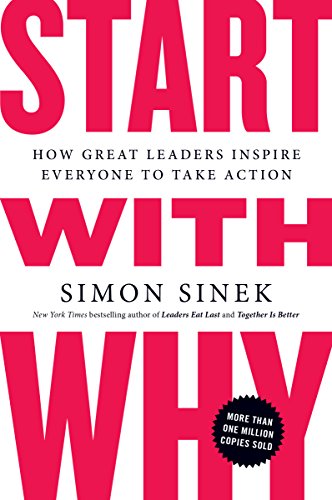

This article is an excerpt from the Shortform summary of "Start With Why" by Simon Sinek. Shortform has the world's best summaries of books you should be reading.
Like this article? Sign up for a free trial here .
Why does it always start with why? Start With Why covers everything you need to know about creating an organization that puts its values at the center of its business. The core concept is simple and straightforward: great businesses know why they’re doing what they’re doing—and they use that mission as their guiding principle.
Given this goal, Start With Why covers three aspects of WHY: 1) defining your WHY, 2) understanding how your WHY affects your company on all levels, and 3) making sure you stay focused on your WHY in the long-term. We’ll cover why, to create a successful business, it starts with why, and how to begin with why in your organization.
Always Start with Why
Why should you begin with why? Your WHY is your central belief. It’s the concept that motivates you to get out of bed in the morning. In terms of an organization, it’s the reason you’re in business.
It starts with why because the WHY leads to the HOW and the WHAT:
- The WHY: This is the vision of your company. It’s the motivation behind your service or product. It’s the mission that you stand for.
- The HOW: The HOW are the practical steps you need to take to achieve your WHY. The HOW is the practical, operational knowledge that brings the vision to life.
- The WHAT: The WHAT is the product or service your selling. It’s the tangible part of your company, and it’s also the easiest to identify.
As an example of how it starts with why, we’ll use technology company Apple:
- WHY: We think differently. We want to challenge the status quo.
- HOW: The way we do this is by making products that are easy to use, elegant, and well designed.
- WHAT: And we just happen to make computers as our products.
The Golden Circle: It Starts with Why
These three elements form The Golden Circle. The Golden Circle looks like a target, where the WHY is the bullseye, the HOW is the middle ring, and the WHAT is the exterior ring. When you start with WHY, you build your company’s message from the inside out. As a result, customers want to engage with your product because they believe in it. They become loyal to you and your company, which builds your brand and spreads your message. This is why you should always start with why.
Don’t Start with WHAT
Unfortunately, most companies don’t start with WHY. That’s because starting with WHY is hard. It involves a lot of introspection, inspiration, vision, and clarity.
Instead, most companies start with WHAT. As the most superficial layer, it’s the easiest to identify and communicate.
As a thought experiment showing how it starts with why, consider Tom, a man going on a date. When he sits down, he starts with his WHAT: “I’m a really successful person. I own a BMW and my best friends are all CEOs or models. I’m rich and I can buy you lots of nice things.”
Obviously, Tom sounds obnoxious, the kind of person who wouldn’t get a second date. Surprisingly, companies communicate exactly like this: “Our product has the best features. Our customers are the biggest companies in the world. We’re making a lot of money, and you should buy our product too.”
But customers don’t buy WHAT – they buy the WHY. Think about Tom starting with WHY: “What gets me out of bed every morning is making an impact on people by solving their problems. It’s the best feeling in the world. I’m also super lucky to get career success doing what I love. I’ve gotten to know lots of interesting people and I’m fortunate to be able to buy nice things.”
Inspiration Versus Manipulation
Because starting with WHY is hard, most companies turn to manipulations to sell a product. Manipulations are tactics that artificially influence customers to buy from your company or use its services. They include Price, Promotion, Fear, Aspiration, Peer Pressure, and Novelty.
Manipulations work, but they’re only short-term solutions. They won’t create loyal, repeat customers. Only inspiration can do that. It starts with why.
Inspiration happens when a company shares its WHY. At that point, the company isn’t selling a product—it’s selling an idea. As a result, the company’s communications are authentic: the company believes in its message, which comes across to customers. Those customers who share the same WHY are attracted to the company, and when the product is good, it establishes trust. That, in turn, brings in more customers, and creates a repeatable cycle of success. Always start with why.
Notable companies that begin with WHY to inspire include Apple, Southwest Airlines, and Harley Davidson.
Inspiring Your Team: It Starts with Why
Great leaders create strong company cultures where everyone works toward the same goal. They inspire employees to believe and pursue WHY instead of WHAT. This is why it starts with why.
An inspired team shows many benefits, including:
- Creating space for innovation.
- When employees understand the company’s WHY, they feel a personal challenge to explore new ways to bring the WHY to life. Steve Jobs didn’t personally build the Mac or the iPod, but he gave his talented team the context around which to innovate and explore the options for bringing the WHY to life.
- Persisting through failure and hard work.
- When employees have a clear sense of WHY, they’re more likely to embrace and move through failure. Failure becomes a step on the way to the goal rather than a catastrophic setback.
- Inspiration revolutionizes employees’ perspective on their jobs. Employees start to see even their least favorite tasks as necessary to achieving their WHY.
- Trust in the team.
- Inspired people realize that everyone–from the CEO down to the most entry-level worker–needs each other to reach their common goal.
- Employees are less focused on self-gain, but instead do what’s best for the mission and the organization as a whole.
- Trust in leadership.
- Inspired employees feel protected in their companies and by their leaders, because they feel leadership make decisions in service of a greater purpose rather than their own self-gain. That gives employees the confidence to take risks, explore, be creative, and push the company forward.
Building an organization that’s based on trust starts with the hiring process. When you have a strong WHY, you can find employees who are also passionate about your mission.
The trick to building a tribe based on inspiration is to look beyond a résumé. Don’t just hire skilled people that you then have to motivate. Instead, hire motivated people who believe in your WHY, and inspire them. Always start with why.
WHY Should Affect Everything You Do
To figure out your WHY, take a step back and examine your motivation behind what you do. It’s more than just making a profit (or at least, it should be). It’s the big, bold vision that motivates your company. Once you have your WHY, you can start focusing on sharing it effectively with the world. Begin with wy.
The Golden Circle Megaphone
The Golden Circle isn’t really flat like a normal bulls-eye target. Instead, it’s a three-dimensional cone.
- At the top of the cone as is the WHY. The WHY is the narrowest, shortest ring, and it’s home to the organization’s top leaders. They’re the ones responsible for creating and sharing the WHY.
- The middle ring of the cone is the HOW. These are the upper-level leaders that figure out how to execute the WHY.
- The bottom–and largest–ring of the cone is the WHAT. This contains all the employees responsible for interacting with customers, selling products and services, and manufacturing goods.
In order to have a strong WHY, every ring of the company needs to be aligned with the organization’s guiding vision. This is why it starts with why. The leaders in the WHY ring need to share the WHY clearly with those in the HOW ring. The HOWs then make sure the WHATs are able to share the organization’s message with everyone else. This creates The Golden Circle Megaphone, which amplifies your message in a way that inspires everyone it touches.
You also have to be able to use your WHY as a filter for making good decisions. Let’s say you’re at a dinner party, and everyone is giving you advice, telling you to buy products like Oreos, celery, and M&Ms. The advice-givers are successful, smart, trustworthy people that want you to buy things that will help you succeed. But if you go out and buy everything they tell you to, you’ll a) waste money and b) purchase products that might not be a good fit for your company.
But when you have a strong WHY, you can make decisions based on that idea. If your WHY is to be healthy and eat wholesome food, you know that buying Oreos and M&Ms isn’t right for you. But celery is aligned with your mission, so you should get that instead. It starts with why.
Ultimately, The Celery Test does three things for a company:
- It provides a guideline for decision making, which helps leaders make better decisions more quickly.
- It makes sure that every action the company takes supports its WHY.
- This creates trust with customers, since they can always count on the company to stay true to its vision.
The Celery Test works with The Golden Circle Megaphone to give companies the means to put WHY at the center of both their messaging and business decisions.
Staying Focused on WHY
Creating a WHY for a company or organization requires a visionary, inspirational leader. Think of Steve Jobs, Bill Gates, and Sam Walton. These leaders are the ones providing the passion and motivation for the business, especially when its first starting out. Always start with why.
But one of the central problems with starting with WHY is that it leads to success. As a business grows, that inspirational leader becomes further and further removed from the daily aspects of the company’s WHAT. When that happens, a company can lose sight of its WHY.
The Split
When a successful company transforms from a WHY organization to a WHAT organization, it’s called “the split.” This happens when the leadership of a company starts focusing too much on measurable metrics, like financial growth. Suddenly, the organization is focusing on its WHAT, not its WHY. And when that happens, companies stagnate. Examples of companies that have gone through the split include Microsoft, AOL, and Walmart.
But the split doesn’t have to happen. Here are strategies for keeping the focus on WHY:
- Make sure that the WHY trickles down from the top to keep every employee focused on the ultimate goal.
- Measure the metrics that count. When you’re focused on your beliefs and use those to measure your success, your company will continue to start with WHY.
- Ensure your company is prepared to transition leadership to people who support the WHY as strongly as current leadership. Even the most visionary leaders can’t lead forever.
Remember, it starts with why. Focus on your WHY first, and the rest of your business will function more smoothly.
———End of Preview———

Like what you just read? Read the rest of the world's best summary of "Start With Why" at Shortform . Learn the book's critical concepts in 20 minutes or less .
Here's what you'll find in our full Start With Why summary :
- What Steve Jobs did right compared to every other business leader
- How to define your organization's WHY
- How to help your organization avoid losing its edge as it succeeds






